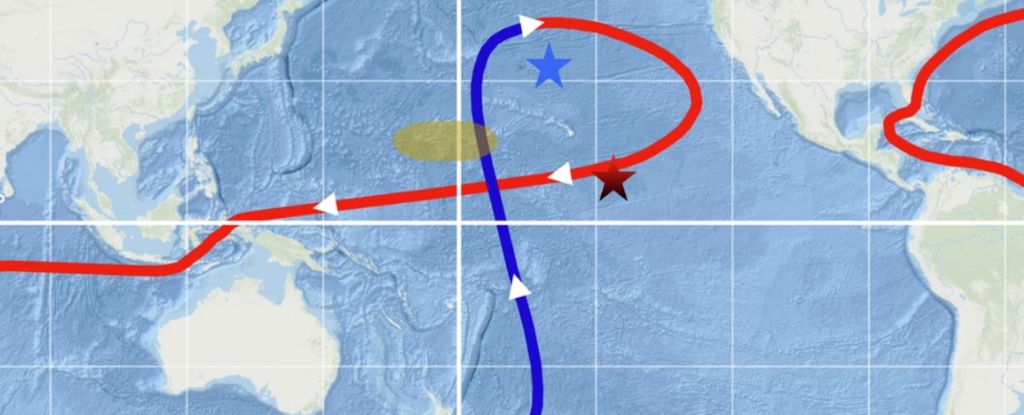
Researchers have discovered a curious radioactive ‘blip’ located deep within the Pacific Ocean.
While examining numerous fine layers of seabed crust, scientists from Germany detected a notable increase in the radioactive isotope Beryllium-10 that occurred between 9 to 12 million years ago.
This beryllium-10 anomaly was pinpointed in the seabeds of both the Central and Northern Pacific, yet the study’s lead author, physicist Dominik Koll from the Helmholtz-Zentrum Dresden-Rossendorf research institute, suggests this peculiar occurrence may extend across the entire Pacific, and potentially globally.
The source of this sudden spike remains unclear, but researchers have proposed a few theories.
Beryllium-10 is a radioactive isotope generated by cosmic rays interacting with the Earth’s atmosphere. When it precipitates from the atmosphere and settles in the ocean, it becomes part of the very slow formation of deep, metal-rich crust layers.
According to Koll and his team, a significant reorganization of ocean currents over 9 million years ago may have led to the increased deposition of beryllium-10 in the Pacific.
Alternatively, this could represent a global event. The aftermath of a nearby supernova or the Solar System’s journey through a sterile interstellar cloud could have escalated cosmic ray activity, which might have accounted for the elevated levels of beryllium-10 found in the ocean.

Ferromanganese crusts that contain beryllium-10 are found in every ocean globally, and they can document a history of ocean chemistry spanning millions of years within just a few millimeters.
Scientists utilize the slow decay rate of beryllium-10 into boron as a dating tool, comparing the ratios of these isotopes to determine the ages of minerals within Earth’s crust.
These ancient and slender crusts serve as nearly uninterrupted geological chronologies encapsulating around 75 million years, but accurately dating them remains a challenge. Standard carbon dating is effective only for about the last 50,000 years, and uranium isotope decay methods don’t provide reliable dating opportunities.
Beryllium-10 is vital for unlocking at least 10 million years worth of geological history within these crusts.
With a half-life of approximately 1.4 million years, beryllium-10 is commonly used to date up to 20 millimeters of ferromanganese crust. Most such crusts range from 1 to 26 centimeters in thickness.

a) Image of ferromanganese crust VA13/2-237KD, featuring a 1 euro coin and a 50-cent Australian coin for scale. b) Map showing the locations of ferromanganese crusts (marked in red, blue, and yellow). (Esri/GEBCO/Garmin/NaturalVue)
However, what Koll and his colleagues uncovered in the Pacific took them by surprise.
“Around the 10 million-year mark, we found nearly twice the amount of 10Be than we had expected,” Koll explains. “We encountered an unforeseen anomaly.”
Much like a bookmark in a book, the team states that this “anomaly could serve as an independent time marker for marine records.”
The researchers validated their findings across various regions of the Pacific Ocean. A single 50-millimeter slice of ferromanganese crust was found to date back over 18 million years.
The growth rate of the crust in the Pacific was found to be 1.52 mm per million years, indicating that the depth of the anomaly correlates to a timeframe of between 10.5 and 11.8 million years ago.
In essence, the presence of the beryllium-10 anomaly in these samples essentially determines their age.

The authors state, “The source of this anomaly is still uncertain,” while suggesting that the Sun’s activity might not have been intense enough to generate such a persistent beryllium influx. They suspect that Earth’s shield against cosmic rays from interstellar space may have fluctuated around 10 million years ago.
Alternatively, a close supernova might have showered the Earth with an unusual quantity of radioactive material.
“Further measurements are needed to determine whether the beryllium anomaly originated from shifts in ocean currents or has extraterrestrial causes,” Koll adds.
“Our goal is to analyze more samples in the future and encourage collaboration from other research teams.”
Only time will reveal whether the beryllium anomaly is a localized or global phenomenon.
The findings were published in Nature Communications.
Related News









